#Medal of Honor: Airborne
Explore tagged Tumblr posts
Text
youtube
THE PILE PRESENTS: X-Play - Soap MacTavish Goes Back to College | 7/24/07
Gimme some of that!
#The Pile#G4#X-Play#Brooktown High: Senior Year#Fight Night Round 3#Viva Pinata#Tom Clancy's Splinter Cell: Double Agent#America's Army#Captain America and the Avengers#Marvel Ultimate Alliance#Call of Duty 4: Modern Warfare#Medal of Honor: Airborne#The History Channel: Civil War - A Nation Divided#PSP#PlayStation 3#Death Jr: Science Fair of Doom#Left Behind: Eternal Forces#Forza Motorsport 2#Attack of the Show!#SDCC 2007#Verizon#Hot Pockets#HP#Harry Potter and the Order of the Phoenix#Gillette#Rescue Dawn#Old Spice#Castrol#Overlord#Progressive
1 note
·
View note
Text

Requested by anon
8 notes
·
View notes
Text
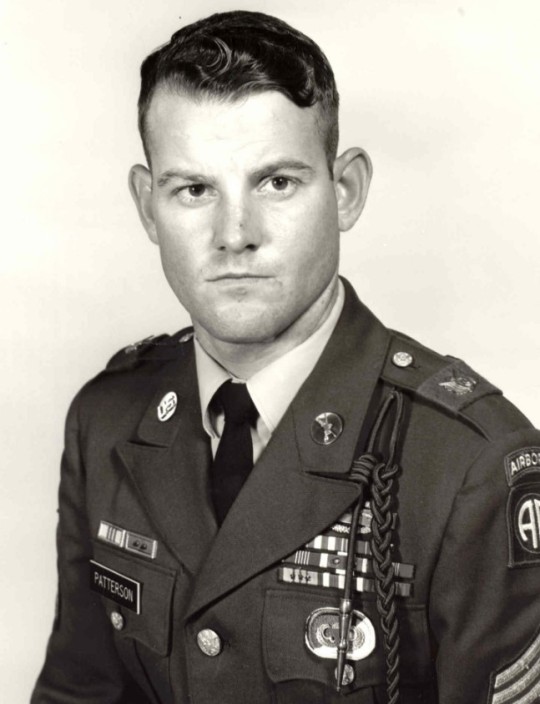
Medal of Honor Monday: Robert M. Patterson
On this day in 1968, a hero engages in an action that would earn him the Medal of Honor. Robert M. Patterson is a self-described “country boy” who grew up helping around his family’s farm.
“I know what it smells like to plow behind a danged old gray mule,” he laughs. “We couldn’t afford no tractors.”
Ultimately, Patterson quit high school to join the Army. He was barely 20 years old on May 6, 1968, when his heroic action occurred.
On that day, then-Sp4c. Patterson was serving as a fire team leader with the 101st Airborne near La Chu, South Vietnam.
The story continues here: https://www.taraross.com/post/tdih-robert-patterson-moh
#tdih#otd#this day in history#history#history blog#Medal of Honor#medal of honor monday#vietnam#101st airborne division#sharethehistory
14 notes
·
View notes
Text
parachuting into italy with a k98k i guess

108K notes
·
View notes
Text

It's 2007, one of the best years of gaming. You had a lot of heavy hitters like Call Of Duty 4: Modern Warfare, Uncharted: Drake's Fortune, Rock Band, Bioshock, Halo 3, Portal, Crysis, Super Mario Galaxy, God Of War III, The Witcher, Mass Effect, Half-Life 2: Episode 2, LEGO Star Wars: The Complete Saga, The Legend Of Zelda: Phantom Hourglass and so on. Yet, out of all those games, I chose to play through an outright class, Medal Of Honor Airborne. Yes, CoD may have been going all Modern Warfare on everyone and Medal of Honor is over still doing WWII games.
So, what sets Airborne apart from other WWII Medal Of Honor games? Well, you get to jump out of a plane at the start of every mission and every single time you die, you do the jump again, with some exceptions. To be honest, I find the jumping mechanic to be poorly explained. The tutorial explains stuff pretty poorly in my opinion because it makes you jump like three times and then you're done and it doesn't matter if you do the landings really well or really poorly either. I pretty much botched every landing I did in the game and I did not care at all because it's not like that affects me during the mission. Ultimately, I found the jumping mechanic to be pretty pointless as it doesn't affect anything at all.
The games runs well enough. There are some visual glitches that don't harm the game but, make it kind of funny. In the very last campaign mission, there were elevator platforms with crates on them that were just popping in and out of existence and when I'd stand on them, it would make my weapons do the same thing too. I just would it kind of funny when stuff like that would happen.
The AI is absolutely stupid af. More than half the time, my ally soldiers would just go to spots and stay there so I am charging into groups of enemies by myself most of the time. When it's just basic enemies, that was fine because I could handle it. But, when it's a section like the bridge where there are like ten guys with rocket launchers and a damn tank...that makes my life just a smallest bit more difficult when my allies are absolutely useless. I know it's a game from 2007 but, that the could be a little bit better.
Outside of those few things, Airborne isn't all that bad of a game. It doesn't even look all that dated graphically, especially if you play any of the other games that I mentioned at the start. Plus, despite only having like five campaign levels, those levels are like 40 minutes long because they give you these large maps with four or five objectives to hit on each map and I really like that a lot. Kind of reminds me of Battlefield V only having five campaign that were an hour or more long because of having multiple objectives on them. I'd definitely recommend playing this game if you have not.
#the dragons speak#video games#medal of honor#medal of honor airborne#ea games#fps#first person shooter#wwii
1 note
·
View note
Text

• Jake McNiece
James Elbert "Jake" McNiece was a US Army paratrooper in World War II. Private McNiece was a member of the Filthy Thirteen, an elite demolition unit. McNiece practiced in several operations throughout world war 2 with the 101st Airborne Division.
James McNiece was born on May 24th, 1919, in Maysville, Oklahoma, the ninth of ten children born to Eli Hugh and Rebecca McNiece, and of Irish American and Choctaw descent. During the Depression, the family moved to Ponca City, Oklahoma in 1931. In 1939, he graduated from Ponca City High School and went to work in road construction, and then at the Pine Bluff Arsenal, where he gained experience in the use of explosives. McNiece enlisted for military service on September 1st, 1942. He was assigned to the demolition saboteur section of what was then the 506th Parachute Infantry Regiment. This section became the Filthy Thirteen, first led by Lieutenant Charles Mellen, who was killed in action on June 6th, 1944, during the Invasion of Normandy. Following Mellen's death, Private McNiece became acting leader of the unit. McNiece is iconically recognized by wearing Native American–style "mohawk" and applying war paint to himself and other members of his unit which, excited the public's interest in this unit. The inspiration for this came from McNiece, who was part Choctaw.
McNiece's deliberate disobedience and disrespect during training prevented him from being promoted past Private when most Paratroopers were promoted to Private First Class after 30 days. McNiece would act as section sergeant and first sergeant through various missions. His first sergeant and company commanders knew he was the man the regiment could count on during combat. McNiece went on to make a total of four wartime combat jumps, the first as part of the Invasion of Normandy in 1944. In the same year he jumped as part of Operation Market Garden in the Netherlands. McNiece would see action again at the Siege of Bastogne, part of the larger Battle of the Bulge. During fighting in the Netherlands, he acted as demolition platoon sergeant. He volunteered for pathfinder training, anticipating he would sit out the rest of the war training in England, but his pathfinder stick was called upon to jump into Bastogne to guide in resupply drops. McNiece received a Bronze Star, Purple Heart, and French Legion of Honor medals for his service and deeds during the war.
His last jump was in 1945, near Prüm in Germany. In recognition of his natural leadership abilities, he ended the war as the acting first sergeant for Headquarters Company, 506th Parachute Infantry Regiment. McNiece would be kicked out of the military in February 1946 after fighting with MP’s. In 1949, McNiece returned to live in Ponca City. He began a 28-year career with the United States Postal Service. His first wife Rosita died in 1952 and, a year later, he married Martha Beam Wonders. They had two sons and a daughter and remained married until his death at age 93.
#second world war#world war 2#world war ii#wwii#military history#american military#army airborne#native american#biography#normandy#market garden
96 notes
·
View notes
Text
D-DAY ANNIVERSARY
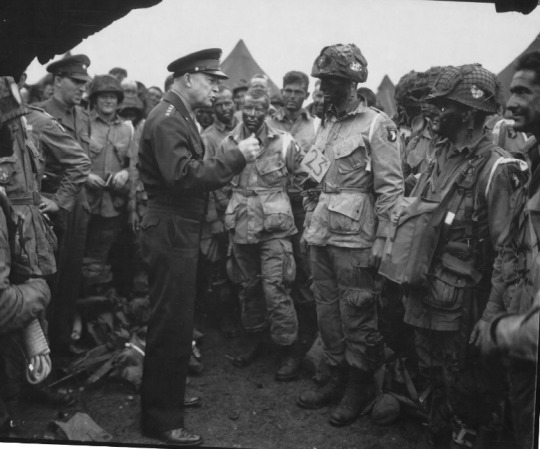
“You are about to embark upon the Great Crusade, toward which we have striven these many months. The eyes of the world are upon you. The hopes and prayers of liberty-loving people everywhere march with you…” With these words, Gen. Dwight D. Eisenhower issued the “Order of the Day” just before the 1944 Allied assault on Normandy Beach. It’s been 80 years since that historic day, and less than one percent of Americans who served in WWII are still alive. However, the impact of their service and sacrifice will live on forever.
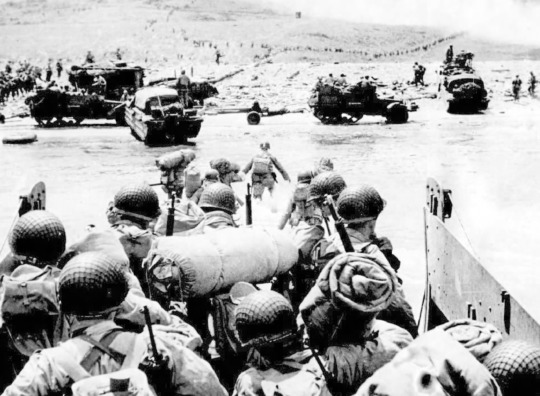
Code named Operation Overlord, planning for D-Day began after France fell to the Nazis in 1940. It involved Allies from several countries and was the largest amphibious invasion in military history. As H-Hour approached (5:30 a.m. local time) on June 6, 1944, demolition teams had already blasted out underwater obstacles planted by German forces. Rangers were already scaling the cliffs to knock out coastal guns, and American and British airborne divisions had been dropped in hedgerows behind the beaches overnight. Soon, the first waves of Infantry would hit the beach.
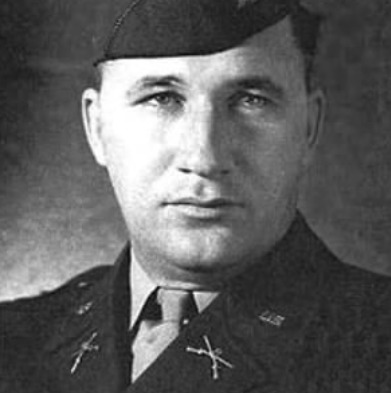
Leonard T. Schroeder, Jr. served in the 2nd Battalion, 8th Infantry, Fourth Division, where he was the commanding officer of Company F.
He has the distinction of being the first man ashore at Utah Beach, the first beachhead, landing fewer than 60 seconds after H-Hour. Recalling the day, Schroeder said that Allied aircraft had bombed the beach heavily, creating craters that could be used as cover. Some of those craters were offshore and hidden by water. When Schroeder’s landing craft pulled ashore, he jumped off and into a water-filled crater six feet deep. He came up sputtering and struggled to rush ashore. Working his way up the beach, he was wounded by shrapnel but continued to fight. He commanded his company for three hours before collapsing into unconsciousness. He woke up at an aid station and was later evacuated to England. Schroeder received the Silver Star.
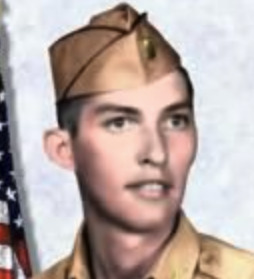
Pvt. Carlton W. Barrett served in the 18th Infantry, 1st Infantry Division and participated in the Normandy Invasion. His unit was in the third wave of Allied soldiers to come ashore at Omaha Beach, landing at about 10:00 a.m. Germans had planted mines on the beach about a foot apart, and the beach was strewn with bodies of soldiers. Barrett landed under heavy enemy fire, wading through neck-deep water. He noticed fellow soldiers around him floundering in the water and rushed to save them from drowning. Once on the beach, Barrett carried dispatches back and forth along the exposed beach while under heavy fire. He also carried wounded soldiers to an offshore evacuation boat. For his dauntless courage, Barrett was awarded the Medal of Honor.

The Allies landed over 160,000 troops on June 6, 1944, with an estimated 10,000 casualties, more than half of which were American. Today, a visit to the Normandy American Cemetery is the final resting place for 9,387 Americans and a sobering reminder of selfless service and the ultimate sacrifice made 80 years ago.
84 notes
·
View notes
Text
2007 was an amazing year for videogames, holy shit. Halo 3, Portal 1, Mass Effect 1, Team Fortress 2, Bioshock 1, Assassin’s Creed 1, Stalker shadow of chernobyl, command & conquer 3 tiberium wars, the Witcher 1, cod 4, uncharted 1, skate 1, supreme commander, half life 2 ep 2, world in conflict, battlestations midway, silent hunter 4, Armored core 4, blazing angels squadrons of wwii, EDF2017, medal of honor vanguard, medal of honor airborne, Metroid prime 3, osu!, ace combat 6, guitar hero iii
37 notes
·
View notes
Text
A lot of my collecting of WWII stuff was inspired by Medal of Honor: Frontline. I was playing it one day the summer I had my first job and I wondered while playing how hard it would be to find a helmet from WWII.
After acquiring said helmet, I set about putting together the uniform of this little knockoff G.I. Joe I had bought when I was a freshman in High School, dubbed "pocket Jimmy Patterson"

Pocket Jimmy Patterson there is a Sergeant in the 101st and was sold as a D-Day soldier but he's actually dressed for Market Garden.
I landed on paratroopers in part because of pocket Jimmy Patterson, and in part because I like airplanes. From there, I went with the 101st over the 82nd because I already thought they had the best patch, I liked the playing card insignia painted on the side of the helmet, the number 101 is aesthetically pleasing, and I didn't know about any other airborne units.
I mean,
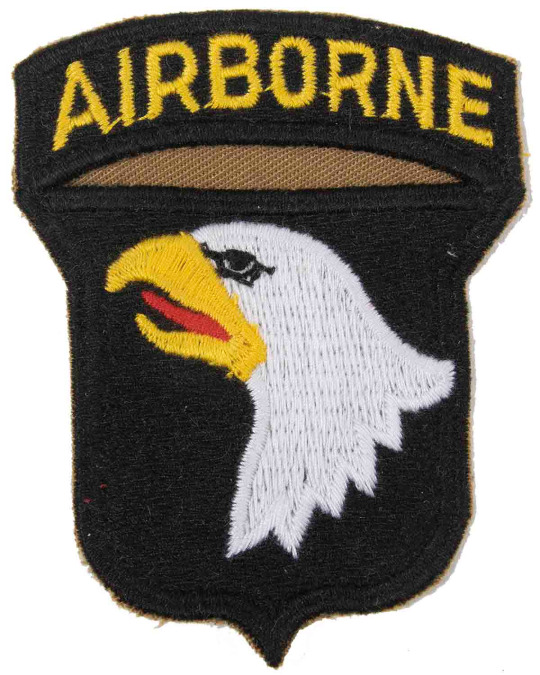

Come on.
(the 101st is the one on the left, and the 82nd on the right, if you didn't already know)
I say all that because if you know anything about WWII collecting and especially re-enacting you know that elite units are dramatically over-represented and for the U.S. nobody more than the 101st, and this can be blamed almost exclusively on Band of Brothers, a show I had not even seen when I landed on the 101st.
How bad is it?
Well, by way of illustration, as a stress response to the final stages of my dissertation I've been retreating into buying WWII paratrooper stuff again, and I was questioning whether I hadn't better go with another unit this time. I had a great great uncle killed in the Philippines in WWII who was in the 11th Airborne so that's an obvious candidate, but of course if you want to stick to Europe and fighting Nazis your options are the 82nd, 101st, or 17th. Of those, the 17th only really got into the war in 1945 and if you want to do Normandy, as some 90% of re-enactments do, then you're between the 82nd and the 101st.
The 82nd has a much longer history than the 101st and, objectively, and I mean this with all implied asterisks and am speaking as though I were a twelve year old who does not know better, the 82nd is cooler, the inferior number/patch notwithstanding.
So I was on a website that is well-regarded for selling WWII militaria and they have a section for patches and I was doing some comparison of original WWII-era divisional patches. The cheapest 101st Airborne patch from WWII this guy has for sale is $175, most of them hovering closer to $300, and some in the $600 range.
11th, 17th, and 82nd patches are in the $50 range.
When I still did re-enacting as the 101st, I remember talking to some of the guys who were disappointed with the rather low "authenticity" standards of our unit (always something of a joke when a considerable number of G.I. re-enactors are in their 40s-60s and dramatically overweight), especially considering that the 101st Airborne are one of the most cartoonishly over-documented units in WWII, for whom reproductions of everything are widely available, and so there's really no excuse not to have your uniform and equipment more or less 100% correct.
Sure enough, trying to do a little research into the 82nd to see what that pool would be like, the resources are shockingly slim. The 101st had two combat jumps in WWII, Normandy and Holland. The 82nd jumped into Sicily, Salerno, Normandy, southern France, and Holland. They have a much longer combat record and are, comparatively speaking, almost totally neglected by idiots like me who are into WWII.
Even as I say all this
I am having a hard time severing the internal connection to 101
#wwii#ww2#re-enacting#my militaria#you know#I never actually pieced together the full Pocket Jimmy Patterson uniform#I never got that M8 scabbard#never got the wire cutters#never got a Thompson#and I never got that shoulder bag#the rest of the stuff I did acquire#at this moment the only stuff on him that I have is the 1911 the helmet the scarf the belt the flag brassard the 1911 mag pouch and#ironically perhaps#that M8 scabbard#I think if I focused on the 82nd I'd try to do the 505th because there's a picture of a guy from the 505th with an M1903A4 before Italy#also they had a rampant lion (panther?) painted on the side of the helmet for Italy#not for Normandy I don't think#the 509 are also cool but they're an independent regiment
18 notes
·
View notes
Text
List of PlayStation Games and Apps that are no longer available (Lists) (Gaming) (PlayStation)
List by @warrenwoodhouse #warrenwoodhouse
Last Updated: 29th November 2024 at 10:32 am
If you would like to contribute to this list, please leave a comment regarding the game or app and platform.
List of Games and Apps that are not on the PlayStation Store and are no longer available for the PlayStation 3, PlayStation 4, PlayStation 5 and future consoles
Forsaken
Star Trek Invasion
Driver
Driver 2: Back on the Streets
Driv3r / Driver 3
Driver: Parallel Lines
Driver 76
WCW Nitro
WCW Mayhem
WCW Backstage Assault
WCW/nWo Thunder
WCW vs. The World
WWF SmackDown!
WWF SmackDown! 2: Know Your Role
WWF SmackDown! Just Bring It
WWE SmackDown! Shut Your Mouth
WWE Crush Hour
WWE SmackDown! Here Comes the Pain
WWE SmackDown! vs. RAW
WWE SmackDown! vs. RAW 2006
WWE SmackDown! vs. RAW 2007
WWE SmackDown! vs. RAW 2008
WWE SmackDown! vs. RAW 2009
WWE Legends of WrestleMania
WWE SmackDown! vs. RAW 2010
WWE SmackDown! vs. RAW 2011
WWE All Stars
WWE ‘12
WWE ‘13
WWE 2K14
WWE 2K15
WWE 2K16
WWE 2K17
WWE 2K18
WWE 2K19
WWE 2K20
WWE 2K21
WWE 2K22
King’s Soul: All Japan Pro Wrestling
King of Colosseum II
King of Colosseum Red
King of Colosseum Red II
Wrestle Kingdom
Wrestle Kingdom 2
All Japan Women’s Pro Wrestling
ECW Hardcore Revolution
ECW Anarchy Rulz
New Japan Pro-Wrestling: Toukon Retsuden
New Japan Pro-Wrestling: Toukon Retsuden 2
New Japan Pro-Wrestling: Toukon Retsuden 3
All Star Pro-Wrestling
All Star Pro-Wrestling II
All Star Pro Wrestling III
TNA Impact!
TNA Impact!: Cross The Line
WWF WrestleMania: The Arcade Game
WWF In Your House
WWF War Zone
WWF Attitude
Army Men: Operation Meltdown
Overboard
Who Wants To Be A Millionaire? Junior Edition
Harry Potter and the Chamber of Secrets: The Video Game
Harry Potter and the Prisoner of Azkaban: The Video Game
Harry Potter and the Goblet of Fire: The Video Game
Harry Potter and the Order of the Phoenix: The Video Game
Harry Potter and the Half-Blood Prince: The Video Game
Harry Potter and the Deathly Hallows Part 1: The Video Game
Harry Potter and the Deathly Hallows Part 2: The Video Game
Shrek Treasure Hunt
Micro Machines v3
Medal of Honor
Medal of Honor: Underground
Medal of Honor: Frontline
Medal of Honor: Rising Sun
Medal of Honor: European Assault
Medal of Honor: Heroes
Medal of Honor: Vanguard
Medal of Honor: Airborne
Medal of Honor: Heroes 2
Medal of Honor (2010)
Medal of Honor: Warfighter
Ace Combat
Ace Combat 2
Ace Combat 3: Electrosphere
Grand Theft Auto
Grand Theft Auto: London 1969
Grand Theft Auto: London 1961
Grand Theft Auto 2
Kick Off World
Tony Hawk’s Pro Skater 3
Tony Hawk’s Pro Skater 4
Tony Hawk’s Underground
Tony Hawk’s Underground 2
Tony Hawk’s Downhill Jam
Tony Hawk’s American Wasteland
Tony Hawk’s Project 8
Tony Hawk’s Proving Ground
Tony Hawk: Ride
Tony Hawk: Shred
Tony Hawk’s Pro Skater HD
Tony Hawk’s Pro Skater 5
Mat Hoffman’s Pro BMX
The Italian Job: The Video Game
MS. PAC-MAN: Maze Madness
Ridge Racer
Ridge Racer Hi-Spec Demo (Demo)
Demo One (Demo)
FIFA 98
FIFA 99
FIFA 2000
FIFA 2001
FIFA 2002
FIFA 2003
FIFA 2004
FIFA 2005
FIFA 06
FIFA 07
FIFA 08
FIFA 09
FIFA 10
FIFA 11
FIFA 12
FIFA 13
FIFA 14
FIFA 15
FIFA 16
FIFA 17
FIFA 18
FIFA 19
FIFA 20
FIFA 21
FIFA 22
FIFA 23
Time Crisis
Spec-Ops Ranger Elite
Hot Wheels Extreme Racing
XGRA Extreme Gravity Racing Association
Future Cop L.A.P.D.
Rascal
Gran Turismo
Gran Turismo 2
Gran Turismo 3
Gran Turismo 3: A-Spec
Gran Turismo 4
Gran Turismo 5
Gran Turismo 6
Gran Turismo Sport
Soviet Strike
Colin McRae Rally
Colin McRae Rally 2.0
Colin McRae Rally 3
Colin McRae Rally 04
Colin McRae Rally 2005
Colin McRae: Dirt
Colin McRae: Dirt 2
Dirt 3
Dirt: Showdown
Colin McRae Rally (2013)
DiRT Rally
DiRT 4
Rapid Racer
Silent Hill
Fighting Force
Mission Impossible: The Video Game
Mission Impossible: Operation Surma
007 Tomorrow Never Dies
X-Men: Mutant Academy
World’s Scariest Police Chases
Konami XXL Sports Series
The Godfather II
Big City Stories
The Matrix Awakens: An Unreal Engine 5 Experience
Saints Row Boss Factory
Blacklight: Retribution (no longer works on the PS4. Works on the PS5 though)
Battlefield 1 Open Beta
The Crew 2 Beta
Dailymotion (app)
IGN (app)
Gamereactor (app)
List of Games and Apps that no longer support PSVR
Minecraft
List of Games and Apps that can only be played on the PlayStation 4 and are still available
SHAREfactory (app)
The Playroom
SingStar
Sky Go (app) (if you have it in your library, you can still use the app)
Demand 5 (app) (if you have it in your library, you can still use the app)
Blacklight: Retribution (no longer works on the PS4. Works on the PS5 though)
List of Games and Apps that are still available and can only be played on the PlayStation 3 if you still have the disc
The Godfather II
List of Games and Apps that can only be played on the PlayStation 3 and are still available
SingStar
Sony Cloud Photos (app)
Changelog
29th November 2024 at 10:32 am: Updated the PSVR list to include Minecraft
26th November 2024 at 5:28 pm: Updated list 1 to include Saints Row Boss Factory, IGN, Gamereactor, Battlefield 1 Open Beta, The Crew 2 Beta and Dailymotion. Updated the PS4 list to include Blacklight: Retribution
25th October 2024 at 9:22 am: Updated list 1 to include The Matrix Awakens: An Unreal Engine 5 Experience and Big City Stories
30th July 2024 at 7:51 am: Created post
#warrenwoodhouse#2024#gaming#list#lists#.list#playstation#playstation games#playstation games that are no longer available
2 notes
·
View notes
Text
The Gliders
Note: I wrote this five years ago for a blog and it was even published in The Prairie Times in the September 2019 issue. Since today is the 80th Anniversary of D-Day, I thought this would be the perfect article to post in honor of it. God Bless the Greatest Generation!

~*~

Growing up, I heard my grandfather fought in WWII, but as a kid I really didn’t know in what capacity. My family knew the basics: he was in the ETO; at various points he was in Iceland, England, France, and Germany. He had medals and he was involved with the gliders. He rarely spoke of his service and on the off-chance he did, he was vague. On the 50th anniversary of June 6th (June 6, 1994) my grandfather was in the nursing home and his younger brother Allen came to visit him. The whole family was there.
Allen made an off-handed comment to him saying, “Well, Bud, you know where we were fifty years ago today.”
“Yeah, D-Day.” And my grandfather began to cry.
Nothing more was said.

Everyone knew better than to pry too much. He avoided flying and planes, and later in life, he suffered PTSD. When he passed, his secrets and experiences died with him. A couple of years later, the miniseries “Band of Brothers” was released and it renewed my family’s interest in Grandpa’s service in WWII. We went through his papers with a fine-tooth comb, rediscovered the medals and patches, and that he had both paratrooper and glider wings. Uncle Allen filled us on a few things. We were able to piece together a little of his story. Then, thanks to the internet, we were able to learn exactly what the gliders were and what their function during the war.
The Germans were the first to use the gliders, in their invasion of France. In response to the German’s success, both America and British created their own versions. Nicknamed the “Flying Coffins,” a high-wind cabin aircraft, the gliders’ framing consisted of plywood and sometimes aluminum, and they were covered in canvas fabric. The glider would be connected to a C-47 aircraft, via a cable, and when both were air borne, the glider would be towed behind, “gliding” along. Without an engine and propellers, it flew silently and undetected by the enemy. The men, the “glider riders,” on the other hand, insisted it was extremely loud inside.

Depending on the type of glider, it would either be transporting fifteen men, or supplies, jeeps, and other equipment. When the glider was near its LZ (Landing Zone), it would be detached from the C-47 and it would crash land. Yes, you read that correctly: crash land. The survival rate wasn’t promising. It was suicidal, really. The glider pilots would have to navigate the engineless aircraft best they could, avoiding trees and stakes that had been erected by the enemy. Hopefully they’d land somewhere near the LZ. The gliders would also be under assault from the Germans. One testimony I heard was of a glider rider awaiting the glider’s detachment from the C-47, he was stunned when the laces on his boots suddenly stood on end. Numb from the adrenalin coursing through his veins, he later learned he had been shot in the foot. Following the crash landing, if the men survived, they would climb out of the glider and immediately enter into combat. Uncle Allen once told us that he had considered joining the airborne and asked my grandfather about it. Grandpa dissuaded him from it. He thought it was too dangerous for his younger brother.

The gliders were used in many major airborne operations throughout WWII: the invasion of Sicily, D-Day, Operation Market Garden, Operation Varsity, and in Operation Thursday in the Far East. In the various operations, the causalities were heavy. The gliders were instrumental during the war, and the glider riders proved themselves over and over again.
After WWII, the gliders were discontinued in favor of the helicopter. In comparison with the paratroopers, the glider riders involved were largely forgotten. There are books out there for those who want to do more in depth research, but more often than naught, the gliders are relegated to a footnote in the history books. Or a small mention on a documentary.

Looked down by many, including the paratroopers, they weren’t issued jump boots, and it wasn’t until July 1944 that they “earned” their right to wear glider wings and receive hazard-duty pay. During WWII, eventually most men were drafted into the military, but to be a “glider rider,” it was voluntary. The strongest and the best persevered against all odds. Why and how could these young men – including my grandfather – do such a dangerous, and in many cases, thankless job?
In my opinion, only the deepest and strongest patriotism could have emboldened them…Along with the fact that they were young and away from their homes for the first times in their lives. The gliders were something relatively new, untested, and risky. It was an adventure like no other and in the end the young men played their part in fighting against evil.
4 notes
·
View notes
Text

#TBT On October 8, 1918, Cpl. Alvin C. York of Golf Company, 328th Infantry, 82nd Division, killed 20 Germans and captured 132, after charging and silencing a machine gun nest. His actions that day are recognized as one of the most significant combat feats by a single Soldier during World War I. For his exceptional heroism in the face of danger, he was awarded the Medal of Honor. #Airborne #ATW #82ndHistory
2 notes
·
View notes
Text

Medal of Honor Monday: Robert G. Cole
On this day in 1944, a soldier is killed in action. Robert G. Cole was a Lieutenant Colonel in the 101st Airborne Division, also known as the “Screaming Eagles.” He is best known for his actions on D-Day, when he was among those invading Normandy.
In fact, his unit was making its first combat jump on that day in June 1944—and Cole had the honor of being the first to jump out of the leading plane.
Unfortunately, the soldiers were badly dispersed during the drop. Cole initially found only four of his own men, but he finally managed to gather up 75 soldiers. His unit was supposed to destroy certain coastal defenses, helping to prepare Utah Beach for the Allied forces that would be landing soon. The story continues here: https://www.taraross.com/post/tdih-robert-cole-moh
#tdih#otd#this day in history#medal of honor#medal of honor monday#world war ii#dday#sharethehistory
21 notes
·
View notes
Text
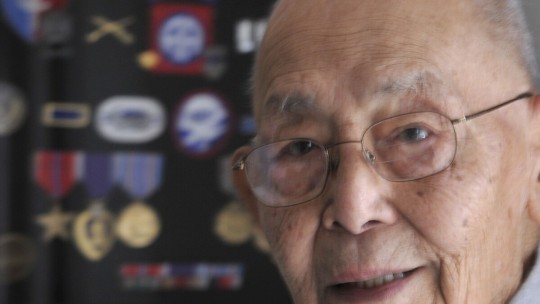
Captain Wesley Ko in front of his decorations for service with the 82nd Airborne Division during WW II. (Photograph courtesy of the Cape Cod Times).
Airborne Chinese American Warfighters on D-Day
On the occasion of the June 6 allied landings at Normandy in 1944, and every National Airborne Day on August 16, we honor three Chinese American veterans of the Second World War.
Glider Infantryman Wesley Ko
Wesley Ko served as a Captain in the 325th Glider Infantry of the 82nd Airborne Division in the European Theater (ETO), earning the Silver Star and numerous other medals including the Purple Heart.
Initially aspiring to be a pilot with the Flying Tigers, Wesley was working in a print shop in Philadelphia when the U.S. entered the war. Despite his employer offering him a draft deferment, he chose to enlist to join his friends. After completing officer candidate school at Fort Benning, Georgia, and overcoming initial delays in assignment possibly due to his Asian ancestry, he joined the 82nd Airborne and subsequently the 325th Glider Infantry Regiment.
During his thirty months of service, Ko fought in six major campaigns including action in Sicily, Naples, Normandy (the day after D-Day), the Battle of the Bulge, the Allied assault on the Siegfried Line, and the battle for Cologne. He was also present at the liberation of the Wöbbelin concentration camp at Ludwigslust.

Capt. Wesley Ko. Ko received the Silver Star for his service in the six major campaigns of the ETO and numerous other medals including the Purple Heart.
In his later years, Ko dedicated his time to preserving the legacy of the 325th Glider Infantry. He shared his experiences through interviews, articles, and books such as The Greatest Generation and his biography On Silent Wings of Courage. He also served as editor of The Glider Tow Line, a quarterly newsletter dedicated to the glider men's stories.
In addition to his military service, Ko co-owned and operated Komak, Inc., an electronics company, with his brother David for 45 years. He had a wide array of interests including computers, boating, fishing, family, poetry, and furniture re-finishing and building.
Ko passed away in E. Falmouth, Mass., on Dec. 15, 2012. He was 93.
Leon Yee: San Francisco Chinatown’s Own
On the night of June 5, 1944, private First Class Leon Yee had found his way onto a paratroop transport plane, flying toward the coast of France. Having grown up in San Francisco Chinatown, Yee had volunteered for the paratroopers in early 1942. He had been motivated by the $50 bonus in hazardous duty pay, which he needed to support his family. After completing jump school at Fort Benning and earning his wings in mid-1942, he trained as a demolition expert and member of H Company in the 507th Parachute Infantry Regiment of the 82nd Airborne Division. According to Chinese American military historian, Montgomery Hom, Yee had concealed from his family how dangerous his duties were. “He tried to hide his combat status by telling his mother he was going to be working with planes,” Hom has written. “But in truth, he was going to be jumping out of planes as an airborne soldier.”
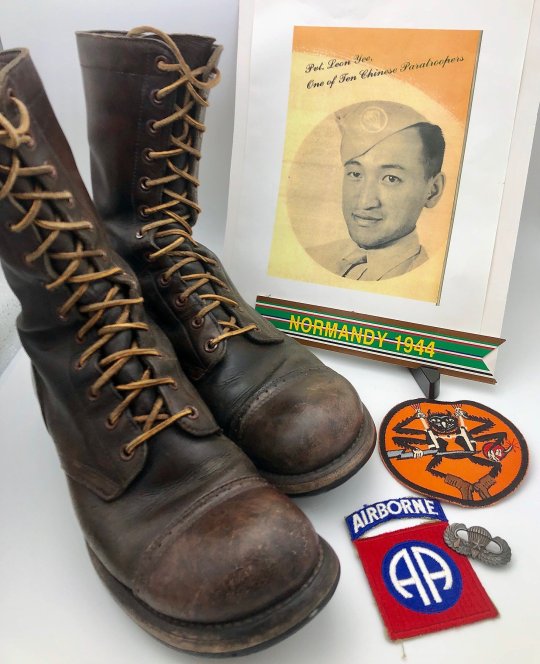
Leon Yee's jump boots, unit patches, and jump wings (from the collection of his nephew and documentarian, Montgomery Hom). The boots were designed initially in 1941 by William P. Yarborough, a test officer in the 501st Parachute Infantry Battalion/Provisional Parachute Group. They are also known as "Corcorans," after the J. F. Corcoran Shoe Company, one of their manufacturers.
At approximately 0200 on June 6, and as part of the then-largest airborne operation in human history, Yee hurled out of his plane, weighed down by more than 100 pounds of equipment, As he descended, he saw sporadic gunfire and small fires on the ground. He landed in a cow pasture northwest of the Merderet River, disoriented in the pitch-black night. under the cover of darkness. German anti-aircraft fire illuminated the sky, hitting some of the aircraft.
After landing without mishap and shedding his parachute harness, Yee took cover in a nearby ditch. He had no idea of his location, as his regiment had experienced the worst drop pattern of all the American airborne units, with only 20% of the paratroopers landing in their designated zones. Hours later, by 4 a.m., a helmetless sergeant from another company of the 82nd Airborne Division joined him. Together, they sat quietly in the ditch until dawn, trying to determine their location. They discovered they were north of their intended drop zone.
By daylight, Yee had joined other regrouped paratroopers regrouped to plant explosives to destroy enemy communication lines, and engage in firefights as elements the 82nd advanced over the next few days toward their main objective, about 5 miles from Utah Beach -- the marshes of the Merderet and Douve. The marshes formed a natural defensive line protecting the western end of the Allied amphibious landing zone. However, the flooded marshes also limited the Allies' potential to break out of the beachhead. They had been flooded to further impede movement. Allied planners deemed control of the bridges at Manoir de la Fière and Chef-du-Pont as vital.
Yee's ad hoc unit reached the La Fière area, and over the next five days attempted to seize causeways and bridges over the Merderet at La Fière and Chef-du-Pont and, further, destroy the highway bridge over the Douve River at Pont l'Abbé (now Étienville). The lightly-armed troops of the 82nd faced counterattacking Wehrmacht units supported by Panzer III and French tanks captured four years earlier.
Yee would see intense combat for five days. During an attack on a German machinegun position, he was severely wounded. A burst of gunfire had struck rocks in front of him, and a ricocheting fragment hit his right temple, just below his helmet. Bleeding profusely from his wound, he lost consciousness. Yee awoke on a cot in a landing craft headed back to England.
Paratrooper Kenneth Gong
On the eve of D-Day Kenneth Gong, a native Chinese American from the town of Cleveland in the Mississippi Delta, performed the first of his two combat jumps, with the 101st Airborne Division.
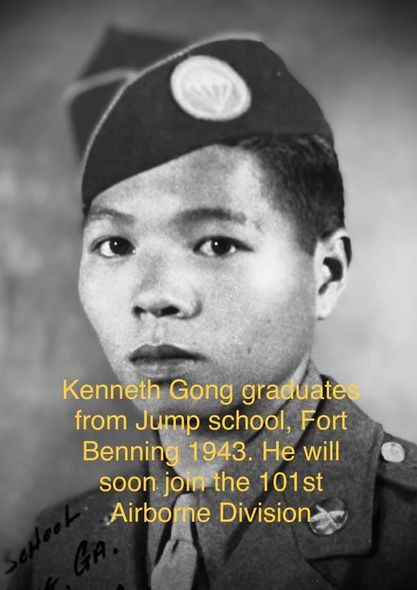
Sgt. Kenneth Gong of the 101st Airborne Division was a native of Cleveland, Mississippi.
Kenny Gong had earned the nickname “Machine Gun Gong” for his proficiency in firing the M3 submachine gun.
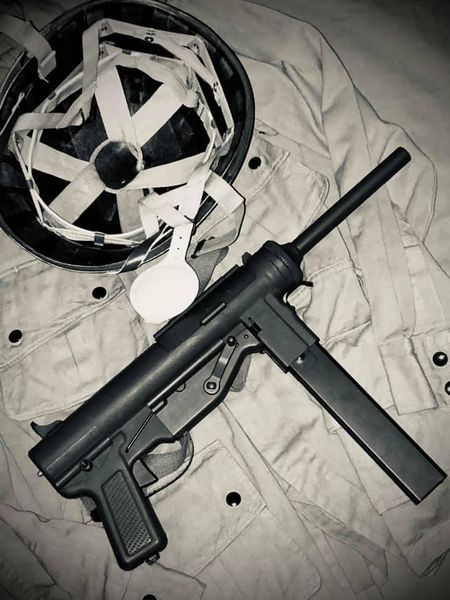
The M3 is an American-made, .45-caliber submachine gun adopted by the U.S. Army in late 1942, as the "United States Submachine Gun, Cal. .45, M3." The M3 was chambered for the same .45 ACP round fired by the Thompson submachine gun, but was cheaper to mass produce and lighter, at the expense of accuracy. Troops commonly referred to the firearm as the "Grease Gun" or "the Greaser" owing to its visual similarity to the mechanic's tool. The weapon is often attributed as the source of the WW II slang used by American soldiers in referring to enemy troops killed by this weapon, who were referred to as having been "greased."
T-4 Sergeant Gong was assigned to the headquarters command, 3rd battalion, 501st Parachute Infantry Regiment, 101st Airborne Division. He saw combat in Normandy and Holland.
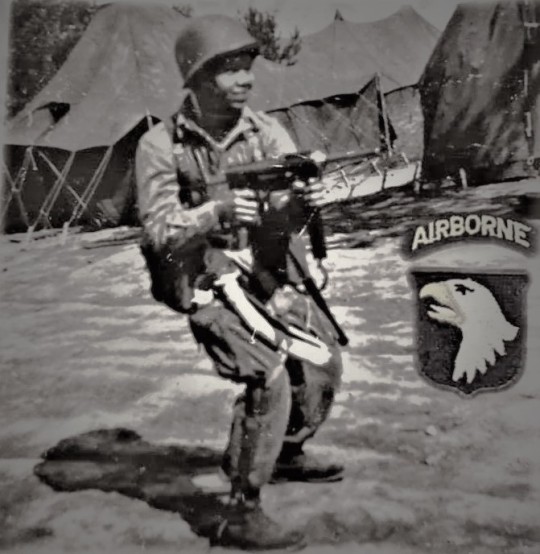
Sgt. Kenneth Gong of the 101st Airborne Division brandishing the M3 submachine gun, his handling of which would earn him respect from his comrades.
When US president Bill Clinton proclaimed October 26, 1998, Chinese Veterans of World War II Day, longtime Delta resident Kenny Gong was one of the White House honorees. His division’s motto remains “Rendezvous With Destiny.”
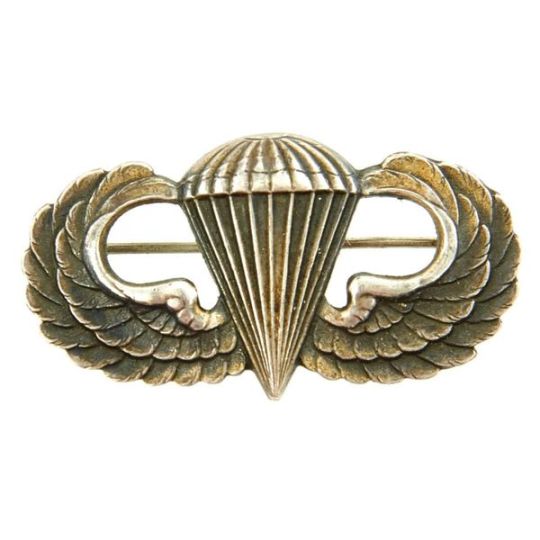
The Parachutist Badge, also commonly referred to as "Jump Wings," is a military badge of the United States Armed Forces. Some services, such as the Marine Corps, officially refer to it as an insignia instead of a badge. The original Army Parachutist Badge was designed in 1941 by Captain (later Lieutenant General) William P. Yarborough and approved by the Department of War in March of that year. The Parachutist Badge replaced the "Parachutist Patch" which had previously been worn as a large patch on the side of a paratrooper's garrison cap. (LTG Yarborough also designed the Senior and Master Parachutist Badges and the addition of stars to portray the number of combat jumps.) The airborne background trimming that is worn behind the badge of those assigned to airborne units is also a contribution of Yarborough.
On this 80th anniversary of the airborne landings in Normandy, let us honor not only the approximately 10 Chinese Americans who served with paratroop and glider units in the European Theater of Operations but all who answered the call to fight for their country during an era of exclusion and segregation.
They also served.
---------------------------------
To read more about Chinese America's warfighters of that era from California, Montgomery Hom's book Fighting on all Fronts - Profiles of WWII Chinese Americans from the Golden State may be purchased here.
#Chinese American airborne troopers#Kenneth Gong#101st Airborne Division#Wesley Ko#82nd Airborne#Leon Yee#Montgomery Hom
3 notes
·
View notes
Text

Master Chief Petty Officer William Goines (September 10, 1936 – June 10, 2024) became the first African American Navy SEAL. SEAL is an acronym for Sea, Air, and Land, which indicates all the environments in which SEALs are trained to operate.
He was born in Dayton. His family moved to Lockland, Ohio. His mother, Lauretta Goines, was a homemaker. His father, Luther Goines, worked in a pool hall and the automotive industry and was co-owner of a gas station.
He never knew Dayton had a public swimming pool since Blacks were not allowed. When state and federal officials required integration, the pool was filled with rocks and gravel. He taught himself to swim in a nearby creek.
He graduated from Lockland Wayne High School and joined the Navy. He was assigned to Malta for 11 months and selected for UDT Training. His class started with five Army Rangers, two foreign Naval Officers, four US Navy Officers, and 85 other enlisted men. After three weeks of training, only 13 men graduated.
He volunteered to join the new Navy SEALs unit. He attended 43 military training schools, which included unarmed combat, SERE school, jungle warfare, demolitions, Airborne school, reconnaissance, and Ranger school. He became “Plankowner” of SEAL Team 2. Fluent in French and Spanish, he served in Cuba, three tours in Vietnam, and other classified missions worldwide.
He joined the Navy Parachute Demonstration Team, the Chuting Stars, and performed 640 free falls and 194 static line jumps over five years. He was the Honor Student in his HALO class.
In 1987, he retired from the military as a Master Chief Petty Officer. His awards include the Bronze Star, the Navy Commendation Medal, the Meritorious Service Medal, a Combat Action Ribbon, and the Presidential Unit Citation.
He became Police Chief for the school system of Portsmouth, Virginia. He was honored at the opening of the Smithsonian’s African American Museum. He received the Lone Sailor Award. #africanhistory365 #africanexcellence
1 note
·
View note
Text
Books of 2023
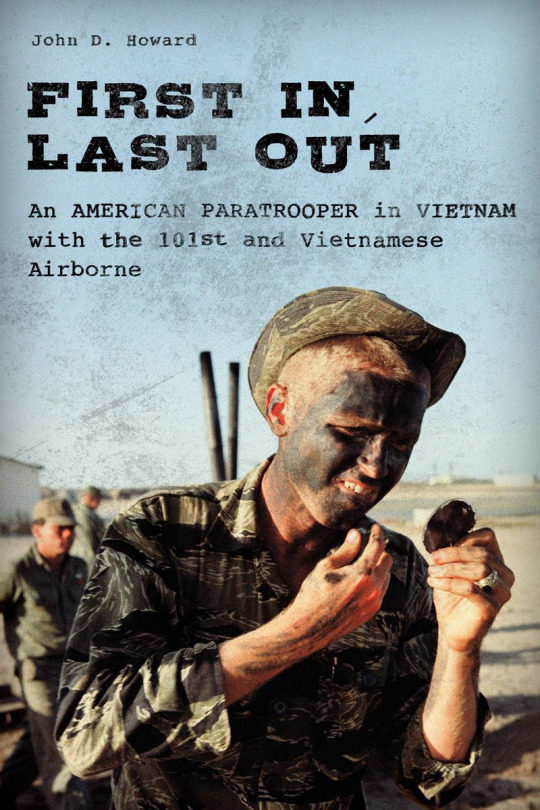
Book 39 of 2023
Title: First In, Last Out: An American Paratrooper in Vietnam With the 101st and Vietnamese Airborne Authors: John Howard ISBN: 9780811766067 Tags: AC-130 Spectre, AUS ADF AA 1st Royal Australian Regiment (1RAR), AUS ADF AA Australian Army, AUS ADF Australian Defence Force, AUS Australia, B-52 Stratofortress, C-130 Hercules, CHE Geneva Conference of 1954 (French Indochina War), Cold War (1946-1991), CUB Cuba, CUB Cuban Missile Crisis, FAC, FRA ADT French Ground Army (Armée de terre), FRA ADT Groupement Mobile 100 (French Indochina War), FRA France, GER Berlin, GER Berlin - Checkpoint Charlie, GER Berlin Wall, GER Germany, GER Munich, KHM Cambodia, KHM Cambodian Incursion (1970) (Vietnam War), KOR Blue House Raid (1968), KOR Camp Greaves, KOR Freedom Bridge, KOR Imjin River, KOR Korea, KOR Korean War (1950-1953), KOR Munsan, KOR President Park Chung Hee, KOR ROK Capital Tiger Division, KOR ROK KATUSA Korean Augmentation to the US Army, KOR ROK Republic of Korea Army, KOR ROKMC Republic Of Korea Marine Corps, KOR UN UNC United Nations Command, KOR US USFK US Forces Korea, LAO FSB 31 (Lam Son 719) (Vietnam War), LAO Lam Son 719 (1971) (Vietnam War), LAO Laos, M113 APC, O-2 Skymaster, PHL Philippines, PHL US USAF Clark Air Force Base, PRK Kim Il Sung, PRK KPA 124th Army Unit, PRK KPA North Korean People's Army, PRK North Korea, SA-2 Guideline SAM, SA-7 Strela SAM, SAM, THA Bangkok, THA Bangkok - Nick's #1 Hungarian Inn, THA RTAFB Nakhon Phanom Royal Thai Air Base, THA Thailand, U-2, UN United Nations, US Ambassador Maxwell Taylor, US Martin Luther King Jr (Civil Rights Leader), US MOH Medal of Honor, US MSTS Military Sea Transportation Service, US MSTS USNS General Leroy Eltinge (T-AP-154), US OH Kent State University, US OH Kent State University Shootings (1970) (Vietnam War), US OH Ohio, US President John F. Kennedy, US President John F. Kennedy Assassination - Dallas TX (1963), US President Lyndon B. Johnson, US President Richard M. Nixon, US Secretary of Defense Robert McNamara, US USA 101st Airborne Division - 1st Brigade, US USA 101st Airborne Division - 3rd Brigade, US USA 101st Airborne Division - Screaming Eagles, US USA 173rd Airborne Brigade - Sky Soldiers, US USA 187th Airborne Regimental Combat Team, US USA 1st Cavalry Division, US USA 1st ID - 3rd Brigade, US USA 1st ID - Big Red One, US USA 23rd Infantry Regiment, US USA 23rd Infantry Regiment - 3/23, US USA 2nd ID, US USA 2nd Infantry Regiment, US USA 2nd Infantry Regiment - 2/2, US USA 327th Infantry Regiment, US USA 327th Infantry Regiment - 1/327, US USA 327th Infantry Regiment - 1/327 - A (ABU) Co, US USA 327th Infantry Regiment - 1/327 - B Co, US USA 327th Infantry Regiment - 1/327 - Tiger Force Recon, US USA 38th Infantry Regiment, US USA 38th Infantry Regiment - 2/38, US USA 502nd Aviation Bn, US USA 502nd Aviation Bn - A Co, US USA 502nd Infantry Regiment, US USA 502nd Infantry Regiment - 2/502, US USA 502nd Infantry Regiment - 2/502 - C Co, US USA 503rd Infantry Regiment, US USA 503rd Infantry Regiment - 1/503, US USA 503rd Infantry Regiment - 2/503, US USA 70th Engineer Bn, US USA 7th ID, US USA 8th Army, US USA 937th Engineer Group, US USA 9th Cavalry Regiment, US USA 9th Cavalry Regiment - 1/9 - F Troop, US USA 9th Cavalry Regiment - 1/9 - Headhunters, US USA Col David Hackworth, US USA Col Jack Jacobs (MOH), US USA Fort Benning GA, US USA Fort Benning GA - Airborne School, US USA Fort Benning GA - IOAC Infantry Officers Advanced Course, US USA Fort Benning GA - NCOCC NCO Candidate Course, US USA Fort Benning GA - Ranger School, US USA Fort Benning GA - US Army Infantry School, US USA Fort Campbell KY, US USA Fort Ord CA, US USA Fort Ord CA - USATC US Army Training Center, US USA General Barry McCaffrey, US USA General Charles H Bonesteel III, US USA General Creighton Abrams, US USA General Fred C. Weyand, US USA General Frederick Koresen, US USA General James A. Hollingsworth, US USA General John Guthrie, US USA General John Heintges, US USA General John McGiffert, US USA General John R. McGiffert, US USA General Normal Schwarzkopf, US USA General Ray Lynch, US USA General Thomas Kennan, US USA General Willard Pearson, US USA General William Coleman, US USA General William Enemark, US USA General William Westmoreland, US USA LRRP Team (Vietnam War), US USA United States Army, US USA USSF Green Berets, US USA USSF Special Forces, US USA USSF Team ODA-221, US USA USSF Team ODA-222, US USA Walter Reed Hospital, US USAF 21st TASS - Rash FAC, US USAF 21st TASS - Sundog FAC, US USAF United States Air Force, US USMC 3rd Marines - 3/3, US USMC United States Marine Corps, US USN NPS Naval Postgraduate School CA, US USN United States Navy, US USN USS Newport News (CA-148), US USN USS Pueblo (AGER 2), USMA West Point, USMA West Point - Camp Buckner, USSR, USSR 1st Secretary Nikita Khrushchev, USSR General Secretary of the Communist Party Leonid Brezhnev, VNM 1968 Tet Offensive (1968) (Vietnam War), VNM 1972 Easter Offensive / Nguyen Hue (1972) (Vietnam War), VNM An Khe, VNM An Loc, VNM An Ninh, VNM Assassination of Ngo Dinh Diem (1963) (Vietnam War), VNM Battle of An Loc (1972) (1972 Easter Offensive) (Vietnam War), VNM Battle of Camp Holloway (1965) (Vietnam War), VNM Battle of Dak To (1967) (Vietnam War), VNM Battle of Dien Bien Phu (1954) (French Indochina War), VNM Battle of Hue City (1968) (Tet Offensive) (Vietnam War), VNM Battle of Ia Drang Valley (1965) (Vietnam War), VNM Battle of Saigon (1968) (Tet Offensive) (Vietnam War), VNM Battle of Tan Son Nhut (1968) (Tet Offensive) (Vietnam War), VNM Bien Hoa, VNM Binh Dinh Province, VNM Binh Long Province, VNM Buddhist Crisis (1963) (Vietnam War), VNM Cam Ranh Bay, VNM Camp Carroll (Vietnam War), VNM Camp Evans (Vietnam War), VNM Camp Holloway (Vietnam War), VNM Central Highlands, VNM Cham People, VNM Cholon, VNM Cholon - Binh Xuyen (Cholon Mafia), VNM Chon Thanh District, VNM Chu Lai, VNM Cua Viet River, VNM Cung Son Special Forces Camp (Vietnam War), VNM Da Nang, VNM Dak To, VNM Di An, VNM DMZ Demilitarized Zone - 17th Parallel (Vietnam War), VNM Dong Ba Thin, VNM Dong Ba Thin Special Forces Camp (Vietnam War), VNM Dong Tre, VNM Dong Tre Special Forces Camp (Vietnam War), VNM DRV Ho Chi Minh, VNM DRV NVA 320B Division, VNM DRV NVA 7th Division, VNM DRV NVA 95th Regiment, VNM DRV NVA 95th Regiment - 5th Bn, VNM DRV NVA Communist B2 Front, VNM DRV NVA General Tran Van Tra, VNM DRV NVA General Vo Nguyen Giap, VNM DRV NVA North Vietnamese Army, VNM DRV Party Secretary Le Duan, VNM DRV Politburo Central Military Committee, VNM DRV VC 5th Division, VNM DRV VC 9th Division, VNM DRV VC Viet Cong, VNM DRV VM Viet Minh, VNM Emperor Minh Manh, VNM FRA 1st Vietnamese Paratroop Bn (French Indochina War), VNM FRA French Expeditionary Corps (French Indochina War), VNM French Indochina War (1946-1954), VNM FSB Mai Loc (Vietnam War), VNM FSB Sarge (Vietnam War), VNM FSB Than Khai (Vietnam War), VNM Gulf of Tonkin Incident (1964) (Vietnam War), VNM Heiu Xuong District, VNM Highway 1, VNM Highway 13 - Thunder Road, VNM Highway 19, VNM Highway 9, VNM Hill 169, VNM Hill 65, VNM Hill 875, VNM Hue, VNM Hue - Le Huan St, VNM Hue - The Citadel, VNM I Corps (Vietnam War), VNM Ia Drang Valley, VNM II Corps (Vietnam War), VNM III Corps (Vietnam War), VNM IV Corps (Vietnam War), VNM Kontum, VNM Kontum Province, VNM Lai Khe, VNM Loc Ninh, VNM LZ Albany (Vietnam War), VNM LZ Sally (Vietnam War), VNM LZ X-Ray (Vietnam War), VNM Mekong Delta, VNM Montagnard, VNM My Canh, VNM My Chanh River, VNM My Lai, VNM My Lai Massacre (1968) (Vietnam War), VNM My Phu, VNM Nha Trang, VNM Nhon Co, VNM Ninh Thuan Province, VNM Operation Arc Light (1965-1973) (Vietnam War), VNM Operation Checkerboard (1965) (Vietnam War), VNM Operation Dong Tien (1970) (Vietnam War), VNM Operation Flaming Dart (1965) (Vietnam War), VNM Operation Hump (1965) (Vietnam War), VNM Operation Lam Son 72 (1972) (1972 Easter Offensive) (Vietnam War), VNM Operation Linebacker I (1972) (Vietnam War), VNM Operation Linebacker II (1972) (Vietnam War), VNM Operation MacArthur (1967-1969) (Vietnam War), VNM Operation Sayonara (1965) (Vietnam War), VNM Operation Silver Bayonet I (1965) (Vietnam War), VNM Operation Van Buren (1965) (Vietnam War), VNM Phan Rang, VNM Phan Thiet, VNM Phu Bai, VNM Phu Sen, VNM Phu Yen Province, VNM Phung Ha, VNM Pleiku, VNM Quang Tri, VNM Quang Tri - Citadel, VNM Quang Tri Province, VNM Qui Nhon, VNM RVN ARVN 11th Airborne Bn, VNM RVN ARVN 15th Regiment, VNM RVN ARVN 18th ID, VNM RVN ARVN 1st ID, VNM RVN ARVN 20th Tank Regiment, VNM RVN ARVN 21st ID, VNM RVN ARVN 31st Regiment, VNM RVN ARVN 3rd ID, VNM RVN ARVN 56th Regiment, VNM RVN ARVN 5th Airborne Bn, VNM RVN ARVN 5th ID, VNM RVN ARVN 6th Airborne Bn, VNM RVN ARVN 8th Airborne Bn, VNM RVN ARVN 9th Airborne Bn, VNM RVN ARVN 9th ID, VNM RVN ARVN Airborne Division - Su-Doan Nhay Du, VNM RVN ARVN Army of the Republic of Vietnam, VNM RVN ARVN CIDG Civilian Irregular Defense Group, VNM RVN ARVN General Cao Van Vien, VNM RVN ARVN General Du Quoc Dong, VNM RVN ARVN General Hoang Xuan Lam, VNM RVN ARVN General Le Van Hung, VNM RVN ARVN General Ngo Quang Truong, VNM RVN ARVN General Nguyen Van Minh, VNM RVN ARVN General Vu Van Giai, VNM RVN Madame Nhu (Tran Le Xuan), VNM RVN Marines, VNM RVN Ngo Dinh Diem, VNM RVN Ngo Dinh Nhu, VNM RVN Nguyen Van Thieu, VNM RVN SVNAF Da Nang Airbase, VNM RVN SVNAF South Vietnamese Air Force, VNM Saigon, VNM Saigon - Missouri BOQ (Vietnam War), VNM Saigon - Pham Van Hai St, VNM Saigon - US Embassy (Vietnam War), VNM Srok Ton Cui, VNM Tan Khai, VNM Tan Son Nhut Air Base, VNM Tan Son Nhut Air Base - Camp Alpha (Vietnam War), VNM Thach Han River, VNM Thanh Binh, VNM Thanh Hoi, VNM Tuy Hoa, VNM US MAAG Military Assistance Advisory Group Vietnam (Vietnam War), VNM US MACV AAG Army Advisory Group (Vietnam War), VNM US MACV ADAT Advisory Team 162 (Vietnam War), VNM US MACV ADAT Airborne Division Assistance Team (Vietnam War), VNM US MACV Advisory Teams (Vietnam War), VNM US MACV BCAT Battalion Combat Assistance Teams (Vietnam War), VNM US MACV DCAT Division Combat Asisstant Team (Vietnam War), VNM US MACV FRAC First Regional Assistance Command (Vietnam War), VNM US MACV Military Assistance Command Vietnam (Vietnam War), VNM US MACV TRAC Third Regional Assistance Command (Vietnam War), VNM US Project 100000 (Vietnam War), VNM US USA 3rd Field Hospital - Saigon (Vietnam War), VNM US USA 85th Evacuation Hospital - Phu Bai (Vietnam War), VNM US USA 8th Field Hospital - Nha Trang (Vietnam War), VNM USA TF Hackworth (Vietnam War), VNM Vietnam, VNM Vietnam War (1955-1975), VNM Vung Tau, VNM War Zone D (Vietnam War), VNM Windy Hill Rating: ★★★★ (4 Stars) Subject: Books.Military.20th-21st Century.Asia.Vietnam War.ARVN.Airborne Division, Books.Military.20th-21st Century.Asia.Vietnam War.Specops.LRRPs, Books.Military.20th-21st Century.Asia.Vietnam War.US Army.Advisor, Books.Military.20th-21st Century.Asia.Vietnam War.US Army.Infantry
Description: Fresh out of West Point, John Howard arrived for his first tour in Vietnam in 1965, the first full year of escalation when U.S. troop levels increased to 184,000 from 23,000 the year before. When he returned for a second tour in 1972, troop strength stood at 24,000 and would dwindle to a mere 50 the following year. He thus participated in the very early and very late stages of American military involvement in the Vietnam War. His two tours—one as a platoon commander and member of an elite counterguerrilla force, the second as a senior advisor to the South Vietnamese—provide a fascinating lens through which to view not only one soldier’s experience in Vietnam, but also the country’s. **
Review: Let me first say that I did enjoy this book - to a degree. That's why it gets 4 stars. But it's important to know that this is not a great book, which with the authors experiences, it really could have been. One of the biggest deficiencies is that he spends more time telling than showing. Good books of this genre give you a first hand view of what happened and what someone experienced. This book is very light on that, especially during his 1965 tour. It gets better with his Korean and Advisor experiences later on, but only just. Instead you get a lot of history of Vietnam, a lot of history of what happened, who went where, what they did. It's all very strategic and 1000 foot level when what this book is supposed to be is very in the weeds at the 1 foot personal experience level. This is a man who participated in a lot of intense operations, worked with incredible people like Foley and Hackworth, and was both a part of ABU and Tiger Recon with the 101st. But you never really get a feel for what it was like to be a member of either. You never get to experience a recon mission, though he was a part of many. You just know that x unit moved to y place, and then this is what happened / this was the outcome.
You get a good overview of the battles, the war, and even a few of the people, but very little else from his time with the 101st.
His time in Korea is a bit better and gives you a good understanding of what happened and some incidents and the people. Also his time as an Advisor is also more personal as well. So maybe it's just a memory thing and things from 72 are easily recalled vs 65.
One thing you'll notice is a lot of ring knocking and naming of generals... so many generals. So just... be prepared for that.
Overall though, a decent book... he needs to work on the tell vs show more than anything. Up next, going to read Foley's Special Men. I always loved Foley's fictional writing, so I have high hopes for his book about his time with Tiger Recon and other units. I have a feeling it's going to be a good compliment to this book.
#Books#Ebooks#Booklr#Bookblr#101st Airborne#US Army#Tiger Recon#MACV#Vietnam War#History#Military History#Non Fiction#Korea#Korean War#ARVN#ARVN Airborne
9 notes
·
View notes